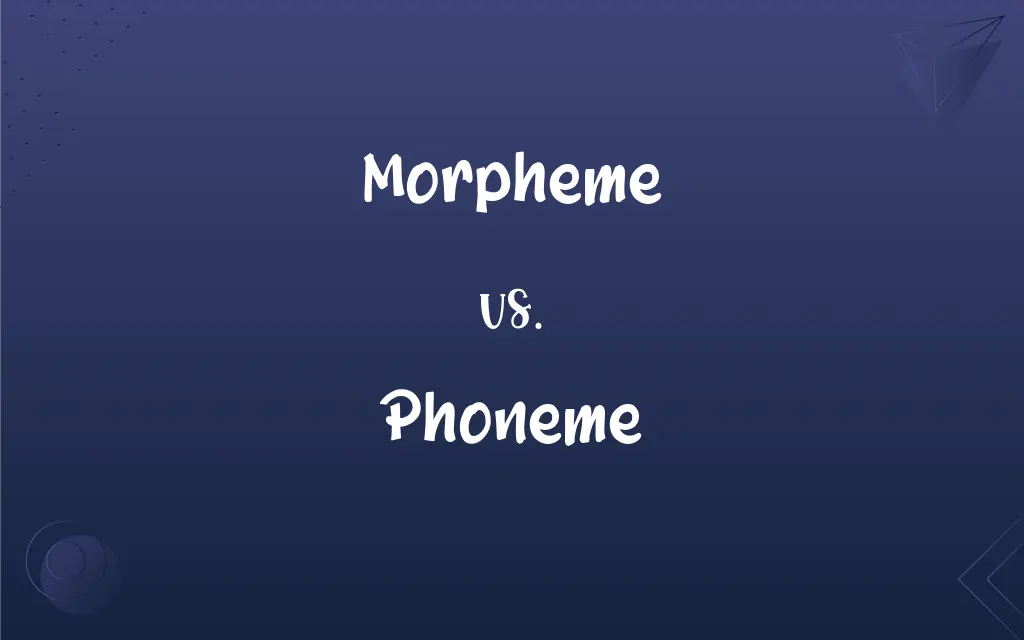Morpheme vs. Phoneme: What's the Difference?
Edited by Janet White || By Harlon Moss || Updated on October 10, 2023
Morpheme refers to smallest grammatical unit, cannot be further divided. Phoneme refers to smallest sound unit, can distinguish words when changed.

Key Differences
Morphemes serve as the foundational units of meaning in a language. Each morpheme carries specific semantic content, influencing the overarching message of a phrase. In contrast, phonemes function as the most elementary sound units that can differentiate meanings between words, devoid of an inherent meaning themselves.
A morpheme may encompass whole words or affixes that modify a word's meaning or create a different form. Whereas, phonemes do not contain meaning and are solely involved in forming distinct auditory divisions between words, affecting pronunciation without influencing meaning.
It is essential to note that while morphemes are intertwined with the syntactic and semantic structure of language, phonemes are chiefly concerned with its phonological and articulatory aspects. The former shapes the meaning and function of words and sentences, while the latter delineates their sound.
In linguistic studies, morphemes are analyzed to understand language structure, composition, and evolution. Inversely, phonemes are investigated to comprehend speech sounds, their production, and their perceptual characteristics.
Morphemes can be free or bound, indicating that they can stand alone or must be attached to other morphemes, respectively. Phonemes, on the other hand, interact with one another within words, shaping the audial identity of words without tethering them to specific semantic information.
ADVERTISEMENT
Comparison Chart
Basic Definition
Smallest unit of meaning
Smallest unit of sound
Concerns
Syntax and semantics
Phonology and articulation
Function in Words
Influences meaning and grammatical form
Influences pronunciation
Constituents
Can be whole words or affixes
Are always sound segments
Presence in Language
Is language-specific
Can be found across various languages
ADVERTISEMENT
Morpheme and Phoneme Definitions
Morpheme
Grammar Element.
The morpheme s makes cat plural as cats.
Phoneme
Speech Sound.
The phoneme /f/ distinguishes fin from bin.
Morpheme
Free Form.
Book is a morpheme that can stand alone.
Phoneme
Sound Unit.
Changing the phoneme /p/ in pat to /b/ gives bat.
Morpheme
Bound Form.
The morpheme ed changes work to worked.
Phoneme
Articulatory Property.
The phoneme /s/ is voiced differently than /z/.
Morpheme
Derivation.
The morpheme ness changes happy to happiness.
Phoneme
Acoustic Identity.
The phoneme /k/ contributes to the sound of kick.
Morpheme
Semantic Unit.
The morpheme un- changes happy to mean not happy.
Phoneme
Non-Semantic.
The phoneme /m/ does not carry meaning on its own.
Morpheme
Minimal meaningful language unit; it cannot be divided into smaller meaningful units
Phoneme
The smallest phonetic unit in a language that is capable of conveying a distinction in meaning, as the m of mat and the b of bat in English.
Morpheme
A meaningful linguistic unit that cannot be divided into smaller meaningful parts. The word man and the suffix -ed (as in walked) are morphemes.
Phoneme
An indivisible unit of sound in a given language. A phoneme is an abstraction of the physical speech sounds (phones) and may encompass several different phones.
Morpheme
(linguistic morphology) The smallest linguistic unit within a word that can carry a meaning.
Phoneme
(linguistics) one of a small set of speech sounds that are distinguished by the speakers of a particular language
Morpheme
The smallest unit of meaning of a language, which cannot be divided into smaller parts carrying meaning; it is usually smaller than a single wordform, such as the -ed morpheme of verbs in the past tense or the -s morpheme of nouns in the plural form.
FAQs
How many phonemes are in English?
English has approximately 44 phonemes, depending on the dialect.
What is a bound morpheme example?
An example of a bound morpheme is “-ed” because it cannot stand alone and must attach to a verb.
How does changing a morpheme affect a word?
Changing a morpheme can alter the meaning or grammatical property of a word.
What's the difference between vowels and phonemes?
Vowels are a type of phoneme, specifically ones created without obstructing the airflow.
Why are morphemes important in linguistics?
Morphemes are crucial for analyzing and understanding the structure, development, and function of languages.
What is a morpheme?
A morpheme is the smallest grammatical unit in a language that carries meaning.
Can a phoneme be a syllable?
No, a phoneme is a single sound, whereas a syllable contains one vowel sound and may include consonant sounds.
What happens if you change a phoneme in a word?
Changing a phoneme in a word alters its pronunciation and can create a different word.
Can a word have more than one morpheme?
Yes, words can have multiple morphemes, such as "unhappiness," which has three morphemes: "un-", "happy," and "-ness."
Are morphemes always audible?
Not necessarily. In written language, morphemes like prefixes or suffixes may not affect pronunciation.
What is a free morpheme?
A free morpheme is one that can stand alone as a word, such as "book."
How are phonemes identified?
Phonemes are identified by their ability to distinguish between words in a language.
Is a morpheme always a word?
No, a morpheme can be a word, but it can also be a prefix or suffix.
Can morphemes impact word class?
Yes, adding a morpheme can change a word from one class to another (e.g., “play” [verb] to “player” [noun]).
Can phonemes be combined in any order?
No, phoneme order is constrained by the phonotactic rules of a language.
How do phonemes relate to letters?
Phonemes are the sounds represented by letters or combinations of letters in writing.
Can a morpheme be a single letter?
Yes, if it carries meaning or function, like "a" in English.
Do all languages have the same phonemes?
No, different languages have different sets of phonemes.
What is a phoneme?
A phoneme is the smallest unit of sound that can distinguish words in a language.
Are all morphemes understandable alone?
No, bound morphemes need to be attached to other morphemes to convey meaning.
About Author
Written by
Harlon MossHarlon is a seasoned quality moderator and accomplished content writer for Difference Wiki. An alumnus of the prestigious University of California, he earned his degree in Computer Science. Leveraging his academic background, Harlon brings a meticulous and informed perspective to his work, ensuring content accuracy and excellence.
Edited by
Janet WhiteJanet White has been an esteemed writer and blogger for Difference Wiki. Holding a Master's degree in Science and Medical Journalism from the prestigious Boston University, she has consistently demonstrated her expertise and passion for her field. When she's not immersed in her work, Janet relishes her time exercising, delving into a good book, and cherishing moments with friends and family.































































